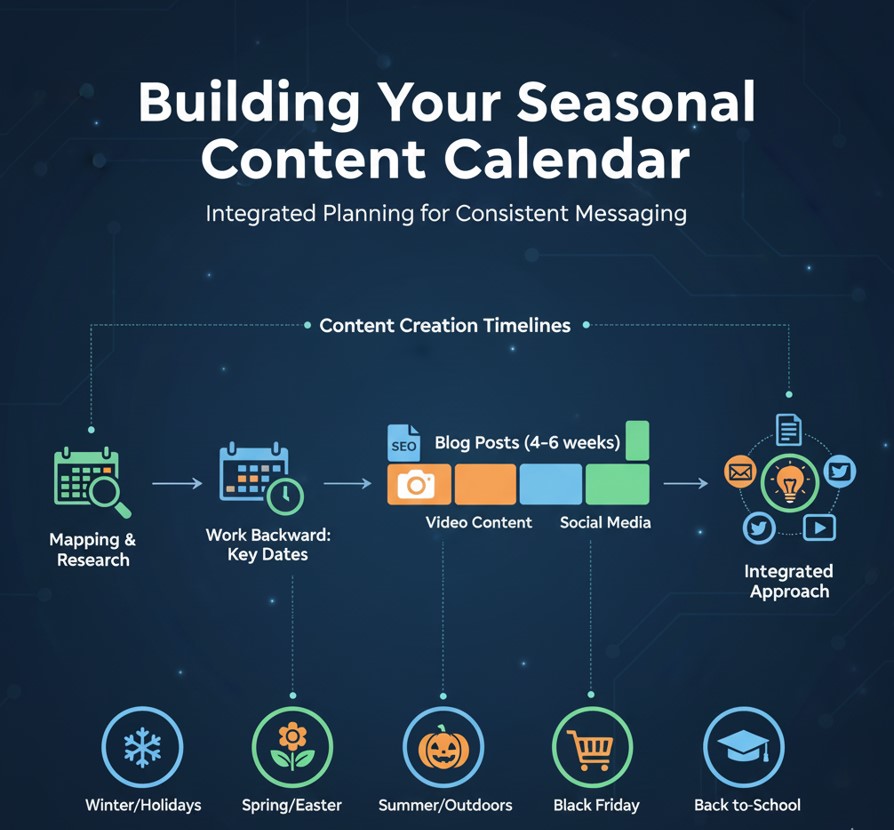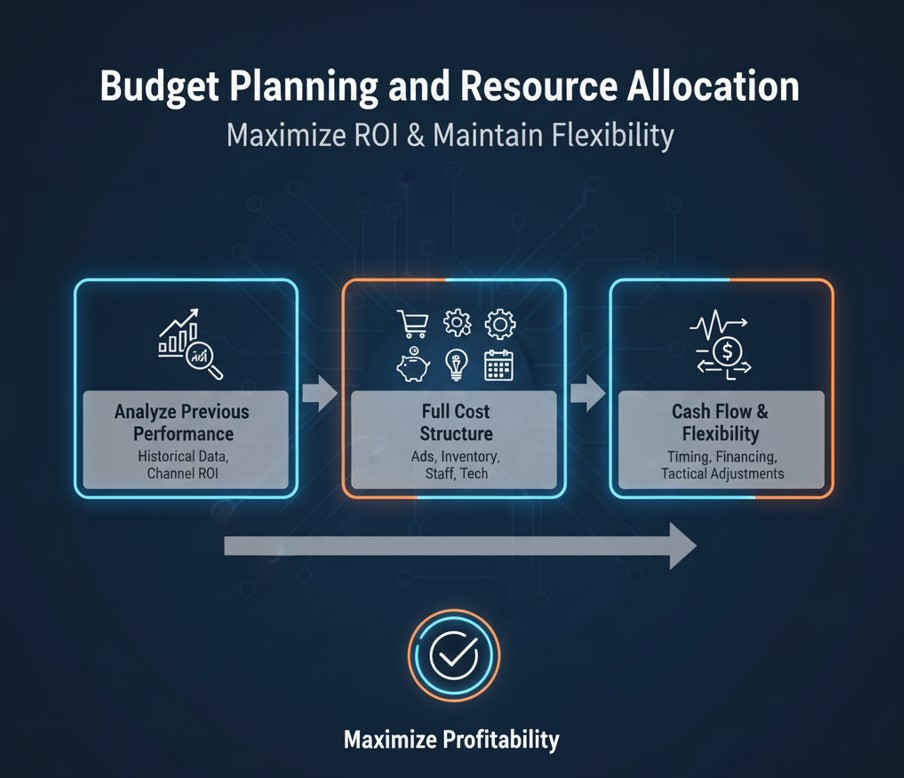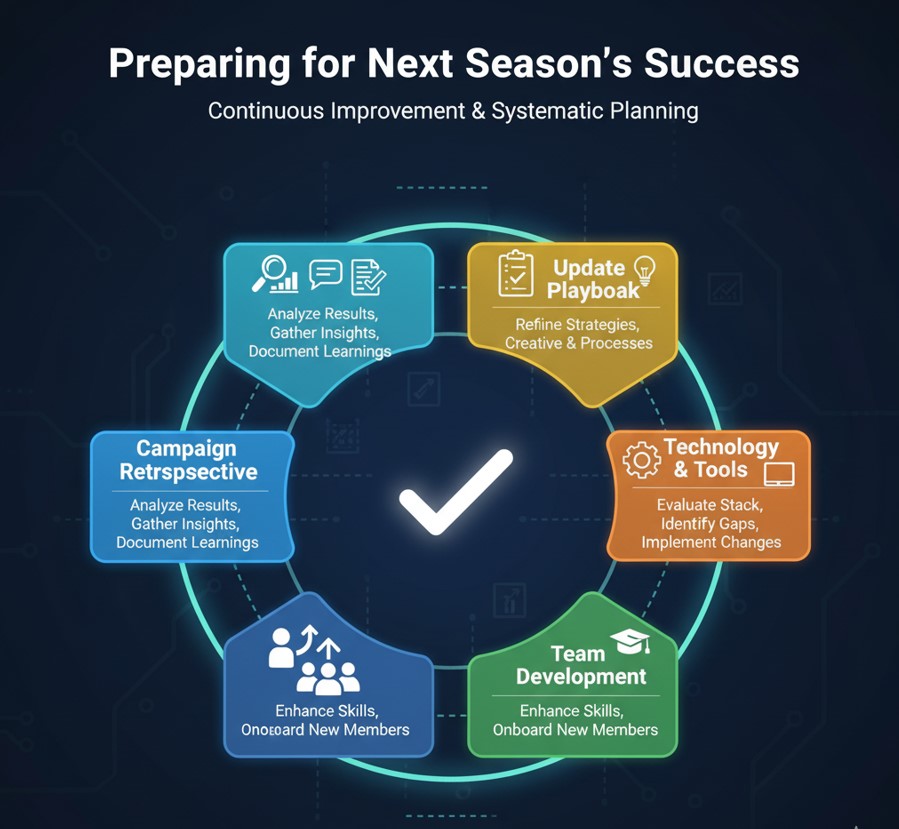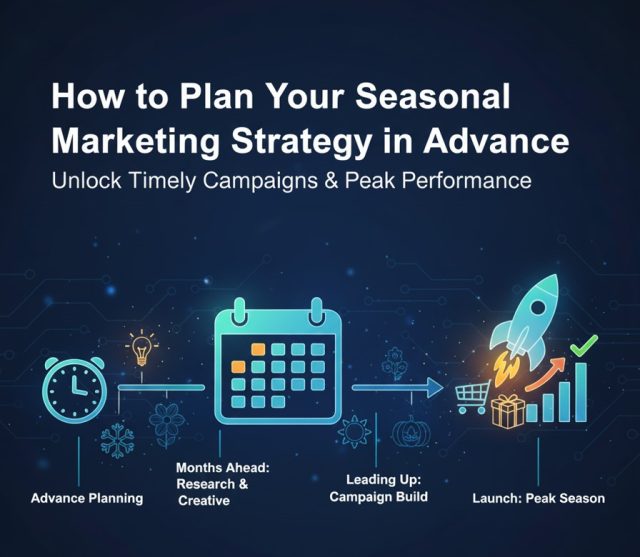Most successful marketing campaigns aren’t created overnight. They’re the result of careful planning, strategic thinking, and months of preparation that happen well before the first ad goes live or the first social media post gets published.
Seasonal marketing represents one of the biggest opportunities for businesses to connect with their audience when purchasing intent is naturally higher. Yet many companies find themselves scrambling at the last minute, throwing together hastily planned campaigns that fail to capture the full potential of peak shopping seasons.
The difference between businesses that thrive during seasonal periods and those that struggle often comes down to one factor: advance planning. Companies that start their seasonal marketing preparation months ahead consistently outperform their competitors who wait until the season arrives.
This comprehensive guide will walk you through everything you need to know about planning your seasonal marketing strategy in advance. You’ll discover how to identify the most profitable seasons for your business, create compelling campaigns that resonate with your audience, and establish systems that make seasonal planning efficient and effective year after year.
Understanding the Impact of Seasonal Marketing
Seasonal marketing taps into natural consumer behavior patterns that occur throughout the year. People’s purchasing decisions are heavily influenced by holidays, weather changes, back-to-school periods, and other recurring events that create predictable demand cycles.
The numbers speak for themselves. Holiday shopping alone accounts for nearly 20% of annual retail sales in many industries. Black Friday and Cyber Monday consistently break online sales records, while Valentine’s Day generates billions in revenue for flower, jewelry, and restaurant industries.
But seasonal marketing extends far beyond major holidays. Summer brings increased demand for outdoor equipment and vacation-related services. Back-to-school season drives sales in everything from clothing to electronics. Even smaller, niche seasons can provide significant revenue opportunities for businesses that recognize and plan for them.
Understanding these patterns allows you to align your marketing efforts with times when your audience is most receptive to your message. When you plan in advance, you can create more sophisticated campaigns, secure better advertising rates, and ensure your inventory and fulfillment systems can handle increased demand.
Identifying Your Business’s Key Seasons
Not every season will be equally important for your business. The first step in seasonal planning involves identifying which periods offer the greatest opportunity for your specific industry and target market.
Start by analyzing your historical sales data from the past two to three years. Look for patterns in revenue, website traffic, and customer acquisition. Pay attention to both obvious peaks and subtle increases that might indicate underexplored opportunities.
Consider your product or service category. Retail businesses often see spikes during traditional shopping holidays, while B2B companies might experience increased activity at the beginning of fiscal years or budget planning periods. Service-based businesses may find seasonal patterns tied to when their target customers have more free time or disposable income.
Geographic factors also play a crucial role. Businesses in tourist destinations might see different seasonal patterns than those in residential areas. Climate can affect demand for certain products, while local events and traditions create unique seasonal opportunities.
Don’t overlook industry-specific seasons that might not be obvious to outsiders. Tax preparation services surge in early spring, while fitness businesses often see increased interest in January and again before summer. Educational services may align with academic calendars, and certain B2B services might correlate with industry conference seasons.
The 12-Month Planning Framework
Effective seasonal marketing requires a structured approach that spreads planning activities throughout the year. The 12-month framework ensures you’re always working on campaigns well in advance while managing current season execution.
January through March should focus on analyzing the previous year’s performance and beginning preliminary planning for the next holiday season. This seems early, but major retailers start their holiday planning in January to ensure adequate product development and inventory preparation time.
April through June represents the ideal time for detailed campaign development. Creative concepts should be finalized, content calendars created, and promotional strategies developed. This period allows for thorough testing and refinement before campaign launch.
July through September shifts focus to execution preparation. Final creative assets are produced, advertising campaigns are set up, and teams are briefed on their roles. Inventory levels are confirmed, and customer service teams prepare for increased volume.
October through December becomes execution mode for holiday campaigns while simultaneously beginning analysis and preliminary planning for the following year. This overlap ensures continuous improvement and prevents last-minute scrambling.
The key to this framework is consistency. Each quarter should have specific objectives and deliverables that build toward successful seasonal campaigns. Regular review meetings ensure nothing falls through the cracks and allow for adjustments based on changing market conditions or business priorities.
Building Your Seasonal Content Calendar

A well-structured content calendar serves as the backbone of your seasonal marketing strategy. It ensures consistent messaging across all channels while preventing last-minute content creation stress that often leads to lower-quality output.
Begin by mapping out all relevant seasons and holidays for your business. Include major holidays, industry-specific events, and any unique celebrations that resonate with your target audience. Don’t forget about awareness months, weekly observances, and cultural events that might provide content opportunities.
For each seasonal period, work backward from your key promotional dates. If you’re running a Black Friday campaign, identify when promotional emails should be sent, when social media teasers should begin, and when you need to start building anticipation through content marketing.
Content creation timelines vary by format and channel. Blog posts might need four to six weeks of lead time to allow for writing, editing, and SEO optimization. Video content often requires even longer, particularly if it involves professional production. Social media content can be created with shorter lead times, but planning still ensures higher quality and better strategic alignment.
Consider content themes that can span multiple touchpoints. A back-to-school campaign might include blog posts about organization tips, social media content featuring products in use, email newsletters with special offers, and video content showing product demonstrations. This integrated approach creates a cohesive brand experience while maximizing content creation efficiency.
Coordinating Across Marketing Channels
Seasonal marketing campaigns perform best when all channels work together toward common objectives. This requires careful coordination and clear communication between different marketing team members or departments.
Email marketing often serves as the primary driver for seasonal campaigns, particularly for e-commerce businesses. Plan your email sequence well in advance, including teaser emails, product announcements, promotional offers, and follow-up messages. Consider how email timing will coordinate with social media posts and paid advertising campaigns.
Social media provides opportunities for real-time engagement and community building around seasonal themes. Plan your posting schedule to include a mix of promotional content, user-generated content, behind-the-scenes glimpses, and value-driven posts that align with seasonal interests.
Paid advertising campaigns require the longest lead times due to creative development and approval processes. Platform-specific requirements vary, with some requiring creative assets weeks in advance for review and approval. Budget allocation decisions also need early planning to secure optimal ad placements during competitive seasonal periods.
Content marketing supports seasonal campaigns by attracting organic traffic and building authority around seasonal topics. Blog posts, guides, and resource pages should be published well before promotional campaigns begin to allow time for search engine indexing and traffic building.
Budget Planning and Resource Allocation

Seasonal marketing often requires significant upfront investment that pays off during peak periods. Effective budget planning ensures you can execute your campaigns without cash flow problems while maximizing return on investment.
Start by analyzing previous seasonal campaign performance to understand which channels and strategies provided the best results. This historical data provides a foundation for budget allocation decisions and helps identify areas where increased investment might yield better returns.
Consider the full cost structure of seasonal campaigns, including creative development, advertising spend, inventory costs, additional staffing needs, and technology requirements. Many businesses underestimate the true cost of seasonal marketing by focusing only on media spend while overlooking production and operational costs.
Cash flow timing is crucial for seasonal campaigns. Expenses often occur months before revenue arrives, particularly for businesses that must invest in inventory or creative production well in advance. Plan for these cash flow requirements and consider financing options if necessary.
Budget flexibility allows you to capitalize on unexpected opportunities or respond to competitive threats during seasonal periods. Reserve a portion of your seasonal budget for tactical adjustments and quick response campaigns that can help you outperform competitors who locked in rigid plans months earlier.
Measuring and Optimizing Performance
Successful seasonal marketing requires continuous measurement and optimization, both during campaigns and in post-season analysis that informs future planning.
Establish clear metrics and KPIs before campaigns launch. Revenue and conversion metrics are important, but also track leading indicators like email open rates, social media engagement, website traffic, and brand awareness measures. These metrics provide early signals about campaign performance and allow for mid-course corrections.
Real-time monitoring during seasonal campaigns enables quick responses to both problems and opportunities. Set up automated alerts for key metrics and establish clear protocols for when and how to make campaign adjustments. Quick response times can mean the difference between salvaging an underperforming campaign and missing seasonal opportunities entirely.
Post-season analysis should be comprehensive and actionable. Document what worked well, what didn’t meet expectations, and what factors contributed to those outcomes. This analysis becomes the foundation for improving next year’s campaigns and should be completed while campaign details are still fresh in team members’ minds.
Preparing for Next Season’s Success

Seasonal marketing success builds on itself through continuous improvement and systematic preparation. The end of each seasonal campaign should immediately trigger planning for the following year’s effort.
Create detailed campaign retrospectives that capture both quantitative results and qualitative insights. Include feedback from team members across different departments, customer service observations, and any external factors that influenced campaign performance. This documentation becomes invaluable reference material for future planning.
Update your seasonal marketing playbook based on lessons learned. Document successful strategies, creative approaches that resonated with your audience, and operational processes that worked well. Also, note what to avoid or improve next time.
Technology and tools evaluation should happen between seasons when you have time to research and implement changes. Consider whether your current marketing stack can support growing seasonal demands and identify any gaps that need addressing before the next planning cycle begins.
Team development and training opportunities often present themselves between peak seasons. Use these periods to enhance team skills, cross-train team members in different areas, and bring new team members up to speed on seasonal marketing processes.
Moving Forward with Confidence
Planning your seasonal marketing strategy in advance transforms what many businesses view as stressful, last-minute scrambles into strategic opportunities for growth and customer connection. The investment of time and resources required for advance planning pays dividends through improved campaign performance, reduced stress levels, and more efficient resource utilization.
Start implementing these strategies immediately, regardless of where you are in the current seasonal cycle. Begin by analyzing your historical data to identify key seasonal opportunities, then work backward to establish planning timelines that will position your business for success.
Remember that seasonal marketing mastery develops over time. Each campaign provides learning opportunities that improve future performance. The businesses that consistently outperform their competitors during seasonal periods are those that commit to systematic planning, continuous measurement, and ongoing refinement of their seasonal marketing approach.
Learn more about: 10 Creative Eid Marketing Ideas for Online Stores









